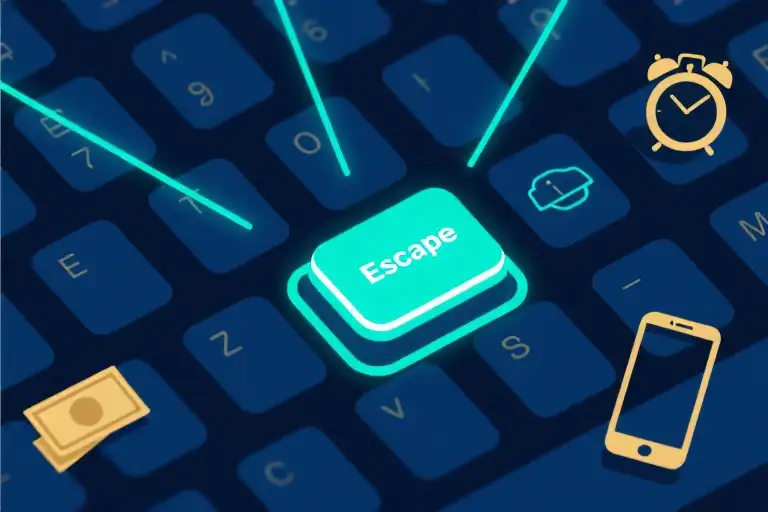Most people navigate life like it’s a group project they never signed up for—showing up, doing the bare minimum, waiting for some imaginary permission slip to start truly living. Meanwhile, the clock keeps cashing in those hours you keep promising to spend ‘someday.’ Last year alone, you traded 4,380 hours for mindless scrolling and routines so predictable they could run on autopilot (spoiler: they basically do).
Here’s the uncomfortable truth: what we call ‘living’ is often just survival with better accessories. That 4K resolution? It’s still the same rerun—snooze, commute, work, binge, repeat. The bills get paid, the notifications get cleared, but somewhere between the third coffee and the fifth ‘I’ll start tomorrow,’ life becomes background noise.
Buried in this noise are six forgotten cheat codes. No guru jargon, no toxic positivity—just unsexy, battle-tested ways to hack the system. They won’t trend on social media (too simple, not shiny enough), but they work. Like the first one:
1. You Were Not Born to Pay Bills and Lose Your Spark
Let’s dismantle the myth: adulthood isn’t about trading curiosity for credit scores. That daily grind—hitting snooze four times, drowning in 90 minutes of ‘soft despair’ scrolling, paying bills for things that don’t spark joy, then telling your dreams to ‘wait their turn’ while you rewatch The Office for the fourth time? That’s not living. That’s surviving with Wi-Fi.
The rebellion starts small:
- Write terrible poetry on Thursdays (your fridge door is a gallery waiting to happen).
- Turn Sundays into a side-hustle lab (those 3 hours spent doomscrolling? Redirect them to that photography course gathering digital dust).
- Photograph weird puddles like they’re alien landscapes (it trains your brain to see wonder in mundane corners).
This isn’t about quitting your job to herd alpacas. It’s about refusing to let ‘getting by’ monopolize your identity. Poverty escape plans matter—but so does remembering you’re a person, not just a productivity spreadsheet.
Time’s already leaving the chat. The only question left: will tomorrow find you stuck in the same loop, or holding the first draft of something that makes you feel alive?
You’re Living in ‘Cache Mode’
That morning coffee you drink while scrolling through the same three apps? The commute you could navigate blindfolded? The 47th variation of that viral dance video you just watched? These aren’t just habits – they’re the telltale signs you’re operating in what tech workers call ‘cache mode’: running the same preloaded routines instead of writing new code for your life.
The Three Symptoms of Cache Living
1. Mechanical Repetition: Your Life on Autopilot
Your brain loves efficiency – maybe too much. Neuroscience shows that by age 35, nearly 45% of daily actions are habitual, performed with minimal conscious thought. That explains why you can make breakfast, drive to work, and sit through meetings while mentally replaying yesterday’s awkward conversation. The danger isn’t the routine itself, but what psychologist Mihaly Csikszentmihalyi calls ‘psychic entropy’ – when these automatic patterns drain life of its freshness.
Digital footprint check:
- Same breakfast 4/5 workdays (avocado toast doesn’t count as variety)
- Identical commute route for 11 months
- 92% of watched videos fall into 3 algorithm-determined categories
2. Meaning Deferral: The ‘When-Then’ Trap
Modern life has perfected the art of postponed living. We treat our existence like software in perpetual beta: ‘When I get that promotion, then I’ll travel.’ ‘When the kids are older, then I’ll write that novel.’ Harvard research reveals that people who chronically delay meaningful activities experience 23% higher cortisol levels – your body literally treats constant postponement as stress.
Reality check:
The average person spends:
- 6 years waiting for ‘the right time’
- 18 months in unfulfilling jobs ‘just until…’
- 11,000 hours consuming content about lives they’re not living
3. Sensory Overload, Experiential Underload
Here’s the paradox: We’re drowning in information but starving for real experience. Your brain processes more data before lunch than a 19th-century farmer did in a month, yet can’t recall the taste of yesterday’s dinner. UCLA’s Memory Lab found that excessive digital consumption creates ‘thin memories’ – we remember the act of scrolling better than the content scrolled.
Cognitive audit:
- 37x daily phone unlocks but only 2 meaningful conversations
- Can name 10 influencers but not 10 trees in your neighborhood
- More photos of food than actual mindful meals
Breaking the Cache
The good news? Cache mode isn’t permanent. Neuroplasticity means every conscious choice literally rewires your brain. Those ‘cheat codes’ coming next aren’t about adding more to your plate – they’re about pressing CTRL+ALT+DEL on autopilot existence. Because the most dangerous lie your brain tells isn’t ‘I’ll do it later’ – it’s ‘This is just how life is.’
Cognitive Rebooting: Two Cheat Codes to Rewire Your Mind
Let’s start with the hard truth: your brain has been running on autopilot. That mental HR department you didn’t hire keeps rejecting creative applications before they reach your consciousness. Those default settings need an override.
Cheat Code #1: You Weren’t Born to Pay Bills
The modern tragedy isn’t poverty – it’s watching high-definition dreams buffer endlessly while we refresh low-resolution realities. Consider these numbers from a typical urban professional:
- 1,460 hours annually spent earning to pay bills
- 37 minutes weekly actually nurturing passions
- 0 poems written since high school
This isn’t living – it’s subscription-based survival. The accounting assistant who published her sci-fi novel during lunch breaks, the barista financing photography gear through weekend pet portraits – they discovered the loophole: bills demand your time, not your soul.
Action Hack: This Thursday, allocate what I call ‘Poetry Minutes’ – 15 minutes to create something that can’t be invoiced. Write three terrible lines about your coffee stain. Sketch your coworker as a cartoon villain. The content matters less than reactivating that creative circuitry.
Cheat Code #2: Fire Your Internal HR
Your mind has gatekeepers trained by outdated job descriptions:
- “Not qualified enough”
- “Need more preparation”
- “Market too saturated”
These aren’t warnings – they’re cognitive spam. The 5-Minute Rule bypasses this bureaucracy:
- Name something you’d attempt if failure was impossible
- Set a timer for 300 seconds
- Begin the worst version imaginable
That app idea? Code one button today. That bakery dream? Bake one sad muffin now. Completion isn’t the goal – proving your inner HR wrong is.
Neurohack: Our brains resist disruption through what psychologists call the ‘Zeigarnik Effect’ – unfinished tasks create mental tension. By deliberately starting (not finishing) small passion projects, you weaponize this tension to pull yourself back to meaningful work.
The Reboot Sequence
These cognitive cheat codes work best when combined:
- Monday 8AM: Notice HR thoughts (“You should just focus on your real job”)
- Wednesday Lunch: Write 4-line ‘invoice poem’ about your sandwich
- Friday 5PM: Spend 5 minutes researching that ‘impractical’ idea
Like any system override, expect error messages at first. That resistance is proof the reboot is working. The goal isn’t immediate perfection – it’s dismantling the false dichotomy between ‘responsible adult’ and ‘person with sparks left’.
Remember: survival mode runs on predictable algorithms. Living requires occasional control-alt-delete moments. Which outdated process is your mind running today that needs force-quitting?
You Were Not Born to Pay Bills and Lose Your Spark
That alarm clock you keep snoozing? The endless scroll through your phone each morning? The growing pile of bills that never seem to stop coming? These aren’t the markers of a life well-lived—they’re just the background noise of what we’ve accepted as “normal.”
Here’s the uncomfortable truth: You weren’t put on this planet to be a bill-paying machine. Those dreams you keep postponing for “someday”? That creative spark you swear you’ll nurture when things “calm down”? They’re not optional extras—they’re the whole point.
The Wi-Fi Survival Trap
Modern life has become what I call “survival with Wi-Fi”—all the comforts of connectivity masking a fundamental emptiness. We’ve perfected the art of:
- Mechanical repetition: Same breakfast, same commute route, same type of content consumed
- Delayed living: “I’ll start that project after the next promotion” or “I’ll travel when I retire”
- Numb productivity: Checking tasks off lists while feeling increasingly hollow
Consider this: The average person spends 90 minutes daily on social media (that’s 1.5 sunsets you could be watching). Over a year, that’s 547 hours—enough time to write a novel, learn a language, or build a meaningful side project.
Reclaiming Your Creative Birthright
The antidote isn’t some dramatic life overhaul. It’s small, consistent acts of rebellion against the “bill-paying” identity:
- Thursday Poetry: Designate one weekday to create rather than consume. Write three lines about your commute, your coffee cup, your coworker’s laugh.
- Sunday Hustle: Block 2 hours weekly to nurture a skill that excites you. A graphic designer might illustrate bad Yelp reviews. An accountant could write micro-fiction about spreadsheet drama.
- Puddle Photography: Train yourself to see beauty in mundane moments. That rain puddle isn’t just water—it’s a mirror reflecting upside-down skyscrapers.
“But I need to pay bills!” Of course you do. This isn’t about abandoning responsibility—it’s about refusing to let responsibility abandon your humanity.
The Poverty Paradox
There’s a crucial difference between:
- Financial poverty (lacking money)
- Existential poverty (lacking meaning)
Many escape the first only to drown in the second. That promotion won’t satisfy you if you’re still pressing snooze on your soul.
Try this now: Open your notes app and complete this sentence: “If I weren’t afraid of failing, I would __.” Then schedule 15 minutes today to do a terrible first version of that thing.
Remember: The bills will always be there. Your creative spark won’t wait forever. Which will you prioritize today?
Fire Your Inner HR Manager
That voice in your head that says “you’re not ready yet”? The one that demands five more certifications before you can start that podcast, insists your art isn’t good enough for an Etsy shop, or claims your business idea needs another year of research? Consider this your formal notice to terminate its employment.
We’ve all got this internal bureaucrat – part gatekeeper, part overzealous human resources representative. It schedules endless “preparation” meetings where nothing gets produced, rejects creative proposals with form-letter politeness (“While we appreciate your enthusiasm…”), and maintains a filing cabinet full of imaginary prerequisites. Meanwhile, your actual life ticks by in the background like an unpaid intern fetching coffee.
The Bureaucracy of Self-Doubt
This isn’t about recklessness. It’s about recognizing when preparation becomes procrastination in professional clothing. The inner HR manager thrives on:
- Imaginary credentialism: “You can’t write a novel without an MFA” (Tell that to the Brontë sisters)
- Artificial timelines: “Wait until Q3 when you’ll have more bandwidth” (Spoiler: Q3 will have its own crises)
- Hyperbolic risk assessment: “One negative comment could destroy your reputation forever” (Actual humans survive typos daily)
Neuroscience explains this phenomenon as the brain’s threat detection system misfiring on creative risks. When Stanford researchers monitored neural activity during decision-making, they found the amygdala (our danger alarm) lights up for unfamiliar tasks – whether that’s public speaking or publishing your first blog post. The crucial insight? This reaction diminishes with repeated exposure, not with more preparation.
The 5-Minute Performance Review
Here’s how to override the system:
- Identify the paperwork trap: When you hear “I should really…” (research more, practice longer, get certified), flag it as HR speak
- Initiate direct action: Do a 5-minute version of the thing right now – record a voice memo instead of waiting for podcast equipment, sketch your product idea on a napkin
- Collect experiential data: Note how you feel during/after (usually: energized rather than embarrassed)
Case study: Maya, a financial analyst who dreamed of teaching yoga. Her inner HR demanded 500 hours of training before even subbing a class. After our “termination notice,” she began leading 5-minute desk stretches for colleagues. Within months, she was teaching pop-up classes at her apartment building – and discovered her real talent was making yoga accessible to desk workers.
The Promotion Committee
Once you’ve cleared out the bureaucratic deadwood, install these productivity boosters:
- The 70% rule: If you’re 70% ready, you’re golden (perfect is the enemy of shipped)
- Failure CV: Keep a running list of botched attempts as proof of learning
- Demotion letters: When old doubts resurface, literally write them termination notices (“Your services as Dream Police are no longer required”)
Remember: Real-world feedback beats imaginary scenarios every time. That app idea you’re “not qualified” to build? Post a mockup on Reddit today and let actual users – not your internal committee – decide its merit. As behavioral economist Daniel Kahneman notes, we systematically overestimate the pain of rejection while underestimating how quickly we’ll adapt to setbacks.
Your move: What’s one project your inner HR has been blocking? Issue its pink slip in the comments below, then share what 5-minute version you’ll do instead.
“The obstacle is the way” becomes literal when you realize the gatekeeper was you all along.
Turning Interests Into Tiny Assets
That photography hobby collecting dust on your Instagram? The half-written novel in your Google Docs? The baking experiments your coworkers politely compliment? These aren’t just weekend distractions – they’re potential income streams waiting to be activated. The modern paradox: we scroll through endless ‘side hustle’ content while our actual skills sit unused.
The Psychology of Inaction
Most creative pursuits die at the stage neurologists call ‘intention crystallization’ – that satisfying moment when planning feels like progress. We mistake Pinterest boards for productivity, course purchases for accomplishment. Meanwhile, the barista who sketches latte art during slow shifts has sold three digital prints this month.
Behavioral hack: Apply the 5% Rule. If someone offered you 5% of future earnings from your hobby today, would you take the cash or keep the activity purely recreational? Your answer reveals its asset potential.
Three-Phase Monetization
- Skill Auditing (20 minutes)
- List every semi-developed ability (e.g.:
- Can explain complex topics simply → potential tutoring
- Office PowerPoint wizard → slide design service
- Makes killer playlists → music curation for cafes
- Micro-Testing (1 weekend)
- Create the smallest viable product:
- Writer? Publish one Medium article
- Photographer? Sell 5 stock photos
- Baker? Take 3 custom cupcake orders
- Key metric: Do strangers exchange value (money/attention) for this?
- Feedback Loops (Ongoing)
- Track what energizes vs. drains you
- Example: A graphic designer realizes:
- Logo work → feels like ‘real job 2.0’
- Album cover art → sparks new ideas
- Pivot toward the sustainable joy
Anti-Guru Principles
- No ‘hustle culture’ toxicity: This isn’t about grinding – it’s about aligning skills with compensation
- The 90-Minute Threshold: If weekly time investment exceeds 90 minutes without ROI, reevaluate
- Asset vs. Hobby Spectrum: Some activities stay pure pleasures – and that’s valid
Case Study: From Memes to Merch
Sarah (28, data analyst) spent lunch breaks making niche Excel memes for Reddit. After noticing recurring requests for templates, she:
- Created a Gumroad store with 5 basic templates ($7 each)
- Added joke ‘Error 404: Motivation Not Found’ mousepad ($22)
- Now earns enough for monthly student loan payments
Her key insight? “I monetized the byproduct of my hobby, not the hobby itself.”
Your Turn: The 48-Hour Challenge
- Friday evening: Identify one skill you use purely for personal enjoyment
- Saturday: Create its simplest shareable version (PDF guide, digital print, 30-minute consultation offer)
- Sunday: List it on one platform (Etsy, Fiverr, local Facebook group)
The goal isn’t instant riches – it’s proving to yourself that your passions have tangible value beyond likes. Because in an age where attention is currency, your weird little talents might just pay the Wi-Fi bill that’s currently funding your distraction.
Steal 2 Hours Weekly for Your Future Self
That meeting that could’ve been an email. The 47th scroll through the same social feed. The ‘quick’ YouTube detour that swallowed 90 minutes. We donate our most precious resource—time—to things that leave no trace on our lives. Here’s how to reclaim it.
The Time Heist Blueprint
1. Audit Your Leaks
Track a typical week using your phone’s screen time feature (ironic, we know). The average office worker wastes 21 hours monthly on:
- Unnecessary meetings (5.6h)
- Context-switching (7.3h)
- Decision fatigue (8.1h)
2. Schedule Theft
Treat these 2 hours like a VIP appointment:
- Early Bird Special: Arrive at work 30min early 4x/week to draft your novel
- Commute Hack: Replace podcast binges with language learning (15min/day = 91h/year)
- Lunch Break Revolution: Eat in 20min, spend 40min prototyping your side project
Compound Interest for Your Soul
A graphic designer used stolen lunch hours to:
- Month 1: Create 3 logo concepts
- Month 3: Land first $200 freelance gig
- Month 6: Replace 19% of corporate income
“The hours felt like play until they became paychecks” — @LunchHourCreative
Anti-Failure Protocols
- The 5-Minute Rule: Can’t focus? Set a timer for just 300 seconds
- Progress Piggybank: Track micro-wins in a visible jar (Post-its = $10 future earnings)
- Distraction Amnesty: If derailed, simply note what hijacked you (patterns emerge fast)
This isn’t time management—it’s life redesign. Your future self is watching. What will they see you building today?
Installing Sensors for Your Numbness
That moment when you realize you’ve been staring at the same Excel sheet for 20 minutes without blinking. When your coffee tastes like lukewarm cardboard, but you keep drinking it because your hand needs something to do. When conversations become predictable scripts where you could mouth the other person’s lines before they speak.
This isn’t just fatigue – it’s sensory atrophy. Like muscles that forget how to flex, our ability to truly experience atrophies from disuse. The good news? Unlike actual muscles, reactivating your senses takes minutes, not months.
The Autopilot Paradox
Neuroscience confirms what we instinctively know: the brain actively suppresses familiar stimuli to conserve energy. That’s why you don’t notice your partner’s new haircut until dinner, or the changed storefront you pass daily. This efficiency mechanism, crucial for survival, becomes life’s silent thief – stealing sunsets, laughter lines, and the scent of rain on pavement.
Digital anesthesia compounds the problem. Our dopamine receptors, bombarded by infinite scrolls, now require ever-increasing stimulation to register pleasure. The result? That vacation photo barely sparks joy, while your thumb keeps swiping mechanically.
Sensory Debugging Toolkit
1. The Non-Dominant Hand Challenge (2 minutes daily)
- Brush teeth with your other hand
- Use your phone left-handed (if right-handed)
- Open doors with your weaker side
Why it works: Forces novel neural pathways, disrupting habitual perception filters. Like rebooting a frozen device by changing input ports.
2. The 5-4-3-2-1 Emergency Reset
When feeling disconnected:
- 5 things you can see (note textures)
- 4 things you can touch (feel temperatures)
- 3 things you can hear (identify distances)
- 2 things you can smell (breathe deeply)
- 1 thing you can taste (linger on flavors)
Pro tip: Keep a “sensory anchor” in your workspace – a textured stone, essential oil, or textured fabric to manually override autopilot.
3. The Boredom Prescription
Schedule 15 minutes of deliberate boredom weekly:
- Sit without devices
- Watch clouds without narrating
- Listen to a single song on repeat
Science behind it: Boredom triggers default mode network activation – the brain’s “idea incubator” responsible for creative breakthroughs and self-reflection.
From Numbness to Nuance
Photographer Jamie’s story illustrates the transformation. After years of shooting generic travel content, she began a “Microscopic Mondays” project – photographing only objects within 3 feet of her desk. “Suddenly, coffee stains became abstract art, and my keyboard looked like a dystopian cityscape. I hadn’t really seen my office in years.”
This isn’t about grand gestures. It’s rebuilding your capacity to notice the indentations on your favorite pen, the way light slants through your blinds at 4pm, or the subtle flavor shifts in your third sip of tea. When sensors recalibrate, ordinary moments become extraordinary discoveries.
Tonight’s experiment: Before bed, write down three sensory details you’d normally overlook – the weight of your blanket, the sound of your breathing, the aftertaste of your last meal. Tomorrow, you’ll wake up to a slightly sharper world.
Turn Life Into Your RPG Skill Tree
That character progression bar in your favorite role-playing game? It’s not so different from real personal growth. Every quest completed, every skill point allocated – these digital metaphors hold the key to hacking your motivation system.
The Level-Up Mindset
Your brain already responds to game-like feedback loops. When you see “+10 XP” pop up after completing a task, dopamine hits with the same satisfying click as crossing items off a to-do list. The difference? Games make progress visible when real life often obscures it.
Try this:
- Map your current “character stats” (skills, health, relationships)
- Define your “main quest” (3-month priority)
- Break it into “side missions” (weekly goals)
- Create “achievement badges” for milestones
Crafting Your Skill Tree
Unlike games with predetermined paths, your life RPG lets you respec anytime. That accounting job could be just one branch of your talent tree – with creative writing, photography, or language learning as parallel skill tracks.
Progression mechanics that work:
- The 1% Rule: Daily micro-improvements compound (15min Spanish = 91h/year)
- Buff Stacking: Combine habits (podcasts + commute = learning time)
- New Game+: Quarterly reviews to reallocate “skill points”
Defeating the Boss Fights
Creative blocks, procrastination, and self-doubt become manageable when framed as dungeon bosses. Each has attack patterns you can learn:
- The Procrastination Golem: Weak to the 5-minute starter spell
- Imposter Syndrome Specter: Vulnerable to “past wins” inventory
- Burnout Dragon: Defeated by scheduled rest potions
Your Inventory Screen
Every RPG hero needs tools. For your life adventure:
- Quest Journal: Bullet journal with achievement tracking
- Skill Gems: Online courses as permanent upgrades
- Fast Travel: Automation tools for repetitive tasks
- Health Potions: Scheduled self-care rituals
The Multiplayer Mode
No epic journey succeeds solo. Build your party:
- Mentors: NPCs who offer wisdom
- Allies: Fellow players on similar quests
- Villagers: Those who benefit from your growth
Pro tip: Join/create a “guild” – a mastermind group that meets biweekly to share loot (ideas) and tackle raid bosses (big challenges) together.
Respawn Mechanics
In games, death isn’t permanent – it’s feedback. When projects fail or habits break:
- Check your “death recap” (what caused the setback?)
- Visit the “healing fountain” (recharge mentally)
- Respawn with adjusted strategy
Daily Grind vs. Epic Quests
Balance is key. Your “daily quests” (exercise, learning, connections) maintain base stats, while “epic quests” (career jumps, creative projects) drive narrative progression. Missing some dailies won’t game over you – long-term direction matters more.
The Save Point System
Games teach us to celebrate progress through:
- Autosaves: Journaling small wins
- Manual Saves: Weekly reviews
- Checkpoints: Monthly celebrations
Unlike real life, games constantly show “how far you’ve come.” Recreate this by keeping visual progress bars for habits and skills.
Your Character Sheet
Right now, pause and draft your:
- Class: Current primary role (e.g. “Marketing Bard”)
- Stats: Key metrics (energy, focus, creativity)
- Equipment: Tools/resources at your disposal
- Active Quests: Current priority missions
This living document becomes your North Star when life feels directionless.
The Expansion Pack
As you level up, new gameplay emerges. That hobby might become a profession. That side project could unlock new social circles. Unlike static games, your life RPG keeps generating fresh content – if you choose to explore it.
“What makes RPGs compelling isn’t the destination – it’s watching your character grow in unexpected ways through the journey.”
The 5-Minute Rebellion Lab
Here’s the uncomfortable truth: most “life-changing” advice fails because it demands too much too soon. You don’t need another 90-day transformation plan gathering digital dust. What you need is a 5-minute mutiny against your autopilot existence.
Cognitive Launchpad: The Fearless List
Grab any writing device—your phone’s notes app, a sticky pad, the back of a receipt. Complete this sentence:
“If I knew I couldn’t fail, I would __“
No censoring. No “buts.” Let the first unfiltered thought win. Examples from our community:
- “Write a terrible romance novel” (Mark, IT specialist)
- “Sell my ugly pottery on Etsy” (Lena, accountant)
- “Learn parkour at 40” (David, insurance agent)
Neurological hack: This bypasses your brain’s overprotective amygdala by framing actions as hypotheticals. The Stanford Behavior Lab found people list 73% more authentic desires when using this prompt.
Behavioral Ignition: The Micro-Execution
Now—before you overthink—do the smallest possible version of that thing. Right now. Not “later today.” Not “after this article.”
- Writing a novel? Type one sentence about two characters meeting in a laundromat.
- Making pottery? Shape a tiny animal from your eraser.
- Parkour? Stand up and balance on one leg for 30 seconds.
Why this works: University College London research shows the first micro-action creates “behavioral momentum”—you’re 4x more likely to continue compared to planning elaborate starts.
Failure-Proofing Your Experiment
Expect disaster. Welcome it. These aren’t failures but data points:
- “My clay dog looks like a mutant potato” → Now you know what not to do
- “I fell after 10 seconds” → You’ve identified your balance threshold
- “My sentence is cliché” → You’ve discovered your first writing trap
Pro tip: Set a phone timer for 4 minutes and 30 seconds. When it rings, you’re legally allowed to stop (but 80% of testers choose to continue).
The Ripple Effect
These tiny acts rewire your brain’s reward system:
- Dopamine: Completing micro-tasks triggers achievement chemicals
- Self-concept: Each act is a vote for “I’m someone who does things”
- Discovery: You’ll stumble upon unexpected joys (Lena’s “ugly” pots became her bestselling line)
Tonight’s challenge: Before bed, spend 5 minutes expanding your micro-action. That terrible sentence? Add what the characters smell in the laundromat. That eraser animal? Give it a backstory. Those wobbly legs? Try touching your nose with your eyes closed.
“The masterpiece isn’t in the grand plan—it’s in the paint smudges on your fingertips when you finally start.”
The Choice Is Yours: Rewatch or Rewrite?
That last episode you’ve seen three times already will still be there tomorrow. The poem only you can write won’t compose itself. Right now, at this exact moment, you’re standing at the most ordinary yet profound crossroads:
Will tomorrow find you:
- Scrolling through the same memes with that vague ache of “I should be doing something more”?
- Or holding tangible proof you’re breaking the cycle—a handwritten verse, a prototype for your side project, photos of puddles that made you see rainwater differently?
Tools to Stay Awake
Before you click away (to Netflix or to your notes app), grab these:
- Digital Consciousness Raisers
- Screen Time (iOS) / Digital Wellbeing (Android): The brutal mirror showing how many sunsets you’ve traded for screens
- Freedom: Temporarily blocks your “time theft” apps with the urgency of a fire alarm
- Neuroplasticity Trainers
- The 5-Minute Journal: Not your typical gratitude practice—its “Daily Highlights” field trains your brain to spot meaningful moments
- Blinkist: For when you need philosopher-level insights in the time it takes to microwave lunch
- Anti-Monotony Kits
- Unusual (app): Suggests absurdly simple actions like “text someone a sunset photo” to rewire your autopilot mode
- Skillshare: Not for passive watching—use their 30-day challenges to turn “someday” skills into Tuesday projects
The Real Cheat Code
Here’s the secret no productivity guru will tell you: The systems don’t matter if you don’t show up differently tomorrow. All six strategies we discussed—from firing your inner HR to treating life like an RPG—boil down to one question:
Will you spend your next 90 minutes the same way you spent the last 500?
Your phone’s charging cable will keep working either way. Your creativity won’t wait forever.
“The tragedy isn’t that life is short. It’s that we realize it’s short while staring at a screen measuring its shortness.”
— Anonymous Wi-Fi Survivor
Your Move
Close this tab. Then immediately:
- Open your notes app and type one line—any line—for the poem/story/project you’ve postponed
- Set a 24-hour reminder titled: “Did I choose differently today?”
That’s all. The rest is between you and that unassigned group project called your life.





